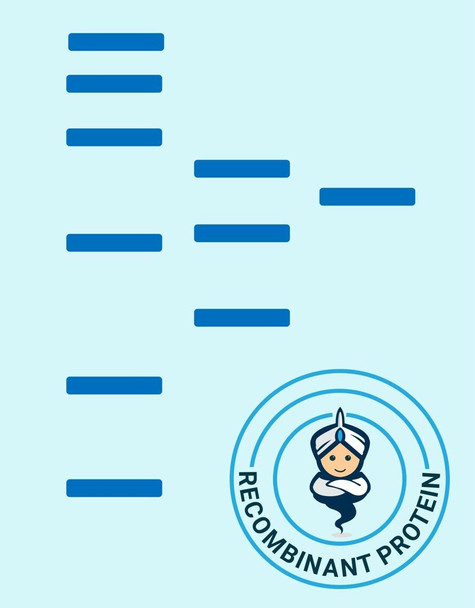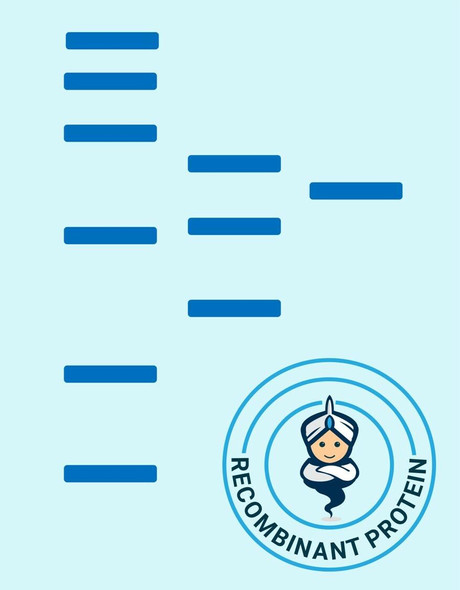Human AKR7A2 Recombinant Protein (RPPB1380)
- SKU:
- RPPB1380
- Product type:
- Recombinant Protein
- Size:
- 20ug
- Species:
- Human
- Target:
- AKR7A2
- Synonyms:
- Aflatoxin B1 aldehyde reductase member 2
- AFAR
- AFAR1
- AFB1-AR1
- Source:
- Escherichia Coli
- Uniprot:
- O43488
Description
| Product Name: | Human AKR7A2 Recombinant Protein |
| Product Code: | RPPB1380 |
| Size: | 20µg |
| Species: | Human |
| Target: | AKR7A2 |
| Synonyms: | Aflatoxin B1 aldehyde reductase member 2, AFAR, AFAR1, AFB1-AR1, AKR7, Succinic semialdehyde reductase, SSA reductase, AFB1 aldehyde reductase 1, Aldoketoreductase 7, AKR7A2. |
| Source: | Escherichia Coli |
| Physical Appearance: | Sterile Filtered clear colorless solution. |
| Formulation: | The AKR7A2 solution contains 20mM Tris-HCl pH-8, 1mM DTT and 20% glycerol. |
| Stability: | Store at 4°C if entire vial will be used within 2-4 weeks. Store, frozen at -20°C for longer periods of time. For long term storage it is recommended to add a carrier protein (0.1% HSA or BSA).Avoid multiple freeze-thaw cycles. |
| Purity: | Greater than 90.0% as determined by SDS-PAGE. |
| Amino Acid Sequence: | MRGSHHHHHH GMASMTGGQQ MGRDLYDDDD KDRWGSELEM LSAASRVVSR AAVHCALRSP PPEARALAMS RPPPPRVASV LGTMEMGRRM DAPASAAAVR AFLERGHTEL DTAFMYSDGQ SETILGGLGL GLGGGDCRVK IATKANPWDG KSLKPDSVRS QLETSLKRLQ CPQVDLFYLH APDHGTPVEE TLHACQRLHQ EGKFVELGLS NYASWEVAEI CTLCKSNGWI LPTVYQGMYN ATTRQVETEL FPCLRHFGLR FYAYNPLAGG LLTGKYKYED KDGKQPVGRF FGNSWAETYR NRFWKEHHFE AIALVEKALQ AAYGASAPSV TSAALRWMYH HSQLQGAHGD AVILGMSSLE QLEQNLAATE EGPLEPAVVD AFNQAWHLVA HECPNYFR |
| Biological Activity: | Specific activity: approximately 0.25-0.3 units/mg.Enzymatic activity was confirmed by measuring the amount of enzyme catalyzing the oxidation of 1 micromole NADPH per minute at 25C. Specific activity was expressed as units/mg protein. |
AKR7A2 participates in the detoxification of aldehydes and ketones.AKR7A2 catalyzes the NADPH-dependent reduction of succinic semialdehyde to gamma-hydroxybutyrate. AKR7A2 is involved in producing the neuromodulator gamma-hydroxybutyrate (GHB). AKR7A2 has extensive substrate specificity. AKR7A2 shows NADPH-dependent aldehyde reductase activity towards 2-carboxybenzaldehyde, 2-nitrobenzaldehyde and pyridine-2-aldehyde (in vitro). AKR7A2 reduces 1,2-naphthoquinone and 9,10-phenanthrenequinone (in vitro). AKR7A2 reduces the dialdehyde protein-binding form of aflatoxin B1 (AFB1) to the non-binding AFB1 dialcohol. AKR7A2 takes part in protection of liver against the toxic and carcinogenic effects of AFB1, a potent hepatocarcinogen.
AKR7A2 Human Recombinant fused to a 39 amino acid His Tag at N-terminal produced in E.Coli is a single, non-glycosylated, polypeptide chain containing 398 amino acids (1-359 a.a) and having a molecular mass of 44 kDa. The AKR7A2 is purified by proprietary chromatographic techniques.
| UniProt Protein Function: | AKR7A2: Catalyzes the NADPH-dependent reduction of succinic semialdehyde to gamma-hydroxybutyrate. May have an important role in producing the neuromodulator gamma-hydroxybutyrate (GHB). Has broad substrate specificity. Has NADPH-dependent aldehyde reductase activity towards 2-carboxybenzaldehyde, 2- nitrobenzaldehyde and pyridine-2-aldehyde (in vitro). Can reduce 1,2-naphthoquinone and 9,10-phenanthrenequinone (in vitro). Can reduce the dialdehyde protein-binding form of aflatoxin B1 (AFB1) to the non-binding AFB1 dialcohol. May be involved in protection of liver against the toxic and carcinogenic effects of AFB1, a potent hepatocarcinogen. Belongs to the aldo/keto reductase family. Aldo/keto reductase 2 subfamily. |
| UniProt Protein Details: | Protein type:Oxidoreductase; EC 1.1.1.n11 Chromosomal Location of Human Ortholog: 1p36.13 Cellular Component: Golgi apparatus; mitochondrion; cytosol Molecular Function:electron carrier activity; aldehyde reductase activity; phenanthrene-9,10-epoxide hydrolase activity Biological Process: xenobiotic metabolic process; carbohydrate metabolic process; aldehyde metabolic process |
| NCBI Summary: | The protein encoded by this gene belongs to the aldo/keto reductase (AKR) superfamily and AKR7 family, which are involved in the detoxification of aldehydes and ketones. The AKR7 family consists of 3 genes that are present in a cluster on the p arm of chromosome 1. This protein, thought to be localized in the golgi, catalyzes the NADPH-dependent reduction of succinic semialdehyde to the endogenous neuromodulator, gamma-hydroxybutyrate. It may also function as a detoxication enzyme in the reduction of aflatoxin B1 and 2-carboxybenzaldehyde. [provided by RefSeq, Oct 2011] |
| UniProt Code: | O43488 |
| NCBI GenInfo Identifier: | 38372871 |
| NCBI Gene ID: | 8574 |
| NCBI Accession: | O43488.3 |
| UniProt Secondary Accession: | O43488,O75749, Q5TG63, |
| UniProt Related Accession: | O43488 |
| Molecular Weight: | 359 |
| NCBI Full Name: | Aflatoxin B1 aldehyde reductase member 2 |
| NCBI Synonym Full Names: | aldo-keto reductase family 7, member A2 (aflatoxin aldehyde reductase) |
| NCBI Official Symbol: | AKR7A2 |
| NCBI Official Synonym Symbols: | AFAR; AKR7; AFAR1; AFB1-AR1 |
| NCBI Protein Information: | aflatoxin B1 aldehyde reductase member 2; AFB1-AR 1; HEL-S-166mP; SSA reductase; aldoketoreductase 7; AFB1 aldehyde reductase 1; succinic semialdehyde reductase; aflatoxin beta1 aldehyde reductase; epididymis secretory sperm binding protein Li 166mP |
| UniProt Protein Name: | Aflatoxin B1 aldehyde reductase member 2 |
| UniProt Synonym Protein Names: | AFB1 aldehyde reductase 1; AFB1-AR 1; Aldoketoreductase 7; Succinic semialdehyde reductase; SSA reductase |
| Protein Family: | Aflatoxin B1 aldehyde reductase |
| UniProt Gene Name: | AKR7A2 |
| UniProt Entry Name: | ARK72_HUMAN |










